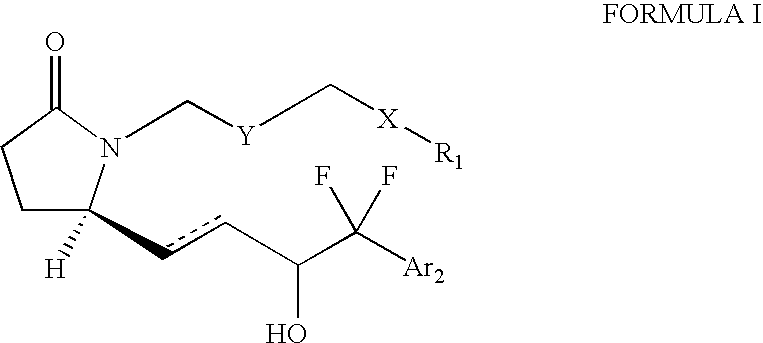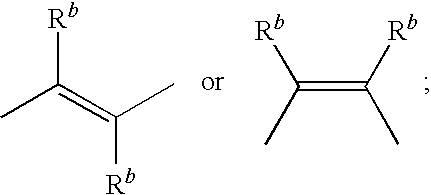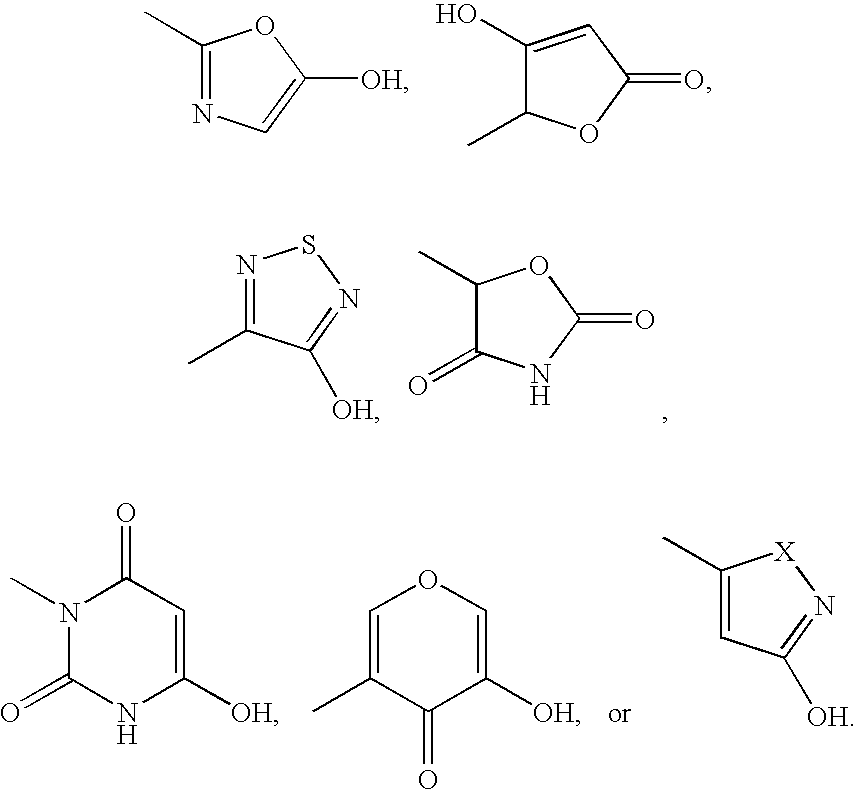EP4 receptor agonist, compositions and methods thereof
a technology of ep4 receptor and composition, applied in the field of ep4 receptor agonist, can solve the problems of unsatisfactory first-line drugs, unsatisfactory drugs formerly used to treat glaucoma, and inability to achieve the effect of elevating intraocular pressur
- Summary
- Abstract
- Description
- Claims
- Application Information
AI Technical Summary
Problems solved by technology
Method used
Image
Examples
preparation 1
7-(2R-formyl1-5-oxo-pyrrolidin-1-yl)-heptanenitrile
Step A: 7-[2R-(tert-Butyl-dimethyl-silanyloxymethyl)-5-oxo-pyrrolidin-1-yl]-heptanenitrile
[0151]To a mixture of NaH (60% in oil, 3.836 g, 0.0959 mol, washed with 25 mL DMF) in DMF (250 mL) was added a solution of 5R-(tert-butyl-dimethyl silanyloxymethyl)-pyrrolidin-2-one (Tetrahdedron: Asymmetry, 1996, 7, 2113) (20.00 g, 87.19 mmol) in DMF (50 mL). The reaction was stirred at room temperature for 1.5 h and a solution of 7-bromoheptanonitrile (16.574 g, 87.19 mmol) in DMF (50 mL) was added. The reaction was stirred at 90° C. for 3 h. The reaction was cooled to room temperature and water (750 mL) was added. The aqueous solution was washed with EtOAc (4×250 mL). The combined organic solutions were washed with water (2×250 mL), dried (MgSO4), filtered, and concentrated. Purification by medium pressure chromatography eluting with a solvent gradient (9:1 hexanes:EtOAc to 7:3 hexanes:EtOAo to 1:1 hexanes:EtOAc) provided 7-[2R-(tert-butyl-d...
preparation 2
Dimethyl 3,3-difluoro-2-oxo-3-phenyl-propylphosphonate
[0154]To a solution of dimethyl methanephosphonate (1.139 g, 9.18 mmole) in 20 ml THF is added dropwise nBuLi (1.6 M in hexanes, 5.73 ml, 9.18 mmole) at −78° C. This solution is stirred 30 min at −78° C. and then added to a solution of 2,2-difluorophenylacetic acid methyl ester (1.75 g, 8.74 mmole) at −78° C. The reaction mixture is allowed to reach rt and then acetic acid (1.5 ml) and 10 ml water are added. The aqueous phase is extracted three times with 30 ml AcOEt, the organic phases are then washed with water, brine, dried on Na2SO4 and the solvent is removed under reduced pressure. Purification of the residual oil by silica gel flash chromatography (3:7 Acetone:toluene) to give Dimethyl 3,3-difluoro-2-oxo-3-phenyl-propylphosphonate as an oil. 1H NMR (CDCl3) δ 7.65-7.40 (m, 5H), 3.71-3.58 (m, 3H), 3.77 (s, 3H), 3.74 (s, 3H), 3.35 (d, J=22 Hz, 2H); MS 279.1 (M+1).
preparation 3
(5R)-1-(4-chlorobutyl)-5-[(1E)-3-hydroxy-4-phenylbut-1-enyl]-pyrrolidin-2-one
Step A: (5R)-(tert-butyl-dimethyl-silanyloxymethyl)-1-(4-chlorobutyl)pyrrolidin-2-one
[0155]To a solution of (5R)-(tert-butyl-dimethyl-silanyloxymethyl)-pyrrolidin-2-one (Tetrahedron: Asymmetry, 1996, 7, 2113) (2.83 g, 12.34 mmol) in 60 ml DMF was added NaH (95%, 325.7 mg, 13.57 mmol) in one portion and the mixture was heated at 50° C. for 30 min. Then 4-bromo-1-chlorobutane (2.96 g, 17.27 mmol) and a catalytic amount of nBu4NI were added and the mixture was stirred at 50° C. for 1 h. The reaction was cooled to room temperature and water (100 ml) was added. The aqueous phase was extracted with AcOEt (4×200 ml), the organic phases were washed with water (200 ml), brine (100 ml), dried on MgSO4, filtered and the solvent was removed under reduced pressure. The residual oil was purified by flash column-chromatography on silica gel (eluent AcOEt 1:Hexanes 1) to provide (5R)-(tert-butyl-dimethyl-silanyloxymethyl)-...
PUM
| Property | Measurement | Unit |
|---|---|---|
| pKa | aaaaa | aaaaa |
| temperature | aaaaa | aaaaa |
| temperature | aaaaa | aaaaa |
Abstract
Description
Claims
Application Information
 Login to View More
Login to View More - R&D
- Intellectual Property
- Life Sciences
- Materials
- Tech Scout
- Unparalleled Data Quality
- Higher Quality Content
- 60% Fewer Hallucinations
Browse by: Latest US Patents, China's latest patents, Technical Efficacy Thesaurus, Application Domain, Technology Topic, Popular Technical Reports.
© 2025 PatSnap. All rights reserved.Legal|Privacy policy|Modern Slavery Act Transparency Statement|Sitemap|About US| Contact US: help@patsnap.com



